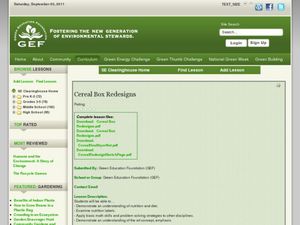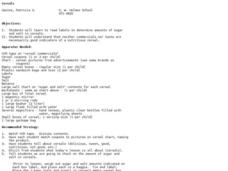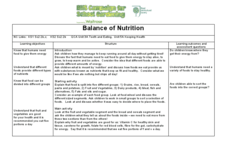Curated OER
Nutrition and the Media: Cereal Box Consumerism
How many treats do you buy each week? Learners investigate diets and how the media tricks consumers into purchasing unhealthy snacks. They will investigate the designs and logos affiliated with cereal boxes and identify specific phrases...
Curated OER
Cereal Box Redesigns
Students examine cereal boxes for nutrition information. In this nutrition lesson plan, students redesign cereal boxes to reflect their nutritional value. Students understand that some cereals contain too high a percentage of...
Lincoln Public Schools
Cereal Box Project
Challenge your class with this fun and engaging engineering design project. The goal, to create a brand new cereal complete with a list of ingredients, a name and logo, and a box to hold it in. Starting with a survey to determine the...
Curated OER
Fortified Breakfast
Students reverse engineer a cereal. In this dietary lesson students identify the minerals that the human body needs to function. Students examine how foods are fortified by food engineers. Students find the amount of iron in a cereal by...
Curated OER
Reading & Using a Nutrition Label
Students discover the importance of healthy eating. Using food nutrition labels, they read and examine the nutritional value. Students collect the data on a spreadsheet and create a graph. They analyze the media influences on product...
Curated OER
ESL: Nutrition/Label Reading
Assist your pupils in making healthy food choices with this lesson. First, have them bring in different kinds of food labels, and put a list of key words on the board (list is not included, but can be nutrition or health-related words)....
Nemours KidsHealth
Breakfast: Grades 3-5
Two lessons promote starting the day with a balanced breakfast. Lesson one challenges scholars to create their own cereal after examining their current favorite cereal, including its nutrition facts. In lesson two, learners set their...
Curated OER
Cereals
Students watch television commercials, then analyze the nutritional value of the cereals. In this health and nutrition lesson, the teacher shows students several cereal commercials, then the students describe the cereals. Students read...
Curated OER
Can You Sell Your Cereal?
Students evaluate television commercials about cereal and create their own cereal product. They watch cereal television commericals and evaluate cereal boxes to compare their features. As a class they create a T-chart to identify words...
Curated OER
Junk Food Jungle
Students become familiar with the nutritional value of foods advertised on television and in magazines. They discuss different types of foods and where snack food fits into a healthy diet. They categorize the foods they eat as healthy or...
Curated OER
Key to Good Health #1: Nutrition
Students learn tips for healthy eating. In this nutrition instructional activity, students learn about the four main food groups, view a food pyramid, and get tips on how to get the most nutrition out of their meals. Students also...
Curated OER
Reading Food Labels
Young nutritionists plan nutritional meals by using the USDA's Food Guide Pyramid. Before constructing their meal plans, they take a close look a food labels and learn how to decipher them. In today's world of obese and unfit children,...
Curated OER
Become a Nutrition Expert
In this nutrition worksheet, 2nd graders read a selection on nutrition and fill in the table using the information from the selection.
Curated OER
Balance of Nutrition
Students explore nutrition by completing a group activity. In this balanced meal lesson plan, students identify the five food groups and discuss their favorite foods from each group. Students utilize illustrations to fill in a fictional...
True Blue Schools
Now, We’re Cooking!
Practice nutritional cooking with a collection of fun meal preparation lessons. Each lesson includes a focus, objective, collaborative activity, and recipe to culminate what young cooks have learned about healthy eating.
Choose My Plate
MyPlate Crossword Puzzle
Reinforce food group facts with a crossword puzzle that highlights healthy nutrition and cooking habits as presented by the MyPlate eating recommendations.
Baylor College
Serving Sizes
Are serving sizes for different foods always appropriate for what you need? In this hands-on activity, learners work in groups to estimate what one serving size of various foods are, and then evaluate their hypotheses by measuring...
Curated OER
Design Your Own Cereal Box
Learners explore the ways in which media messages work and the ways in which consumers are targeted.
Curated OER
Plan a Meal Fun
Discuss helping with the family grocery shopping. View a teacher drawn map of a grocery store and discuss where the breads, meats, and dairy products are located. Practice categorizing foods as breads and cereals, fruits, vegetables,...
Curated OER
Imports and Exports for Making a Food Pyramid
Students examine the food pyramid and discuss it nutritional value. They play a game to determine what types of foods and number of servings they need to complete food pyramids. they can i"import" or "export" cards with foods they need...
Curated OER
Coffee & Chocolate: Knowing Healthy Foods
An article relaying vital information about health and nutrition are the backbone of this lesson on eating the right foods. A series of activities are used to help upper graders understand the science supporting our understanding of what...
Curated OER
Nutrition
Learners determine which foods help keep our bodies healthy. They identify the six food groups and classify different food items into the correct categories of the food pyramid. They evaluate for one week the foods that they eat and...
Education Outside
Grains and Food
Gather up a variety of foods made from grains. Cereal, oats, pasta, rice, breads, cookies, crackers, to name a few. Put them in plastic containers or plastic bags. Then do a show-and-tell type demonstration and present all the types of...
Curated OER
Counting Calories
Pupils evaluate the health of breakfast foods. They create and solve word problems using cereal nutrition data. They solve additional problems formulated in class and write short essay on what they learned.

























